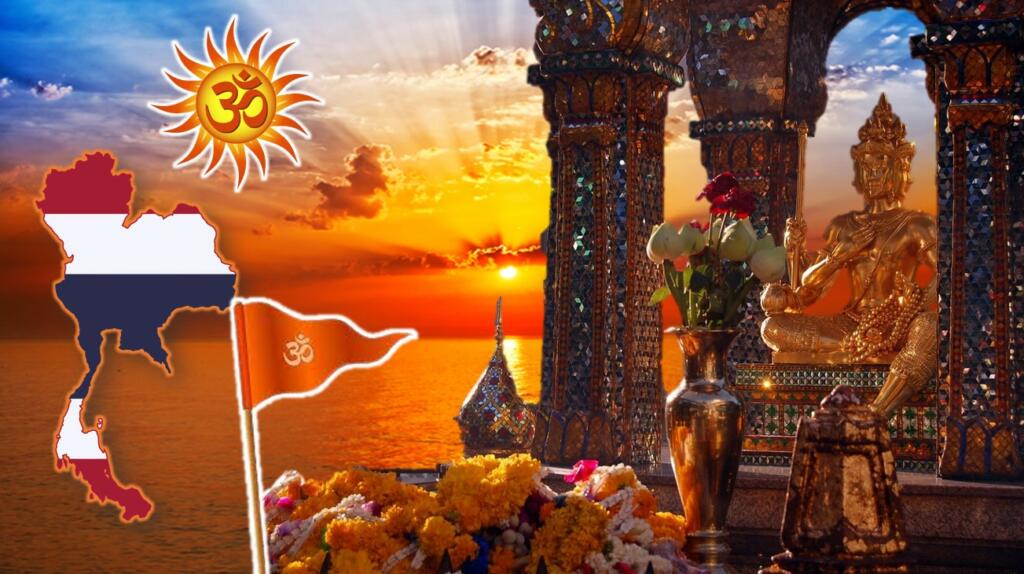Taking the series forward of visiting countries that have a major Hindu populace or have been influenced by Hinduism over the centuries, we now tow our caravan in the beautiful, picturesque country of Thailand. Currently, Buddhists (95 percent) are the majority in the country while Hindus are in a minuscule minority, comprising 0.03 percent of the population, according to a 2015 census. However, it wasn’t the case always.
The Early Historical Period saw India forge transoceanic trade relations with several Southeast Asian nations including Thailand. Suvarnabhumi has many references in our ancient Indian literature and scriptures which refer to present-day “South East Asia” and in particular Thailand.
It is pertinent to note that the capital city Bangkok and its international airport is named Suvarnabhumi Airport. It was named by King Bhumibol Adulyadej who was an ardent reader of the Buddhist and Hindu scriptures. The airport even depicts a scene of Samudra Manthan, an event that is crucial and significant to Hinduism.
What will likes of @sunetrac say when they behold giant sculpture of Samudra Manthan (described in Bhagavata Purana, Mahabharata, Vishnu Purana) at Suvarnabhumi Airport Thailand? Conch displayed too! But dare any Thailand national speak against it. It can happen only in India! pic.twitter.com/P8Skg19Gmc
— Manoshi Sinha (@authormanoshi) January 13, 2020
Khmer empire and Thailand absorbing Hinduism
It is believed that Hinduism first arrived through the traders and the merchants who took voyages to the golden land. However, as mentioned in our previous essay, it was the neighbouring country of Cambodia that spread Hinduism in Thailand.
When the Khmer Empire came to power in Thailand, Hinduism remained the dominant religion until Jayavarman VII (reigned 1181-1218) became the bigger figure in the region. The Khmer empire brought Hinduism with it and Thailand rapidly adopted the syncretic faith.
Read More: Hinduism in Cambodia
Thailand’s former capital of Ayutthaya was named after Ayodhya, the birthplace of the Hindu god Rama situated over 3,500 km far. Though Buddhism was the main religion of the Kingdom of Ayutthaya, Hindu scriptures had a major influence on its culture and society.
Khmer people, too, believe in reincarnation much like the Hindus. Traditional marriages involve the matching of horoscopes just like traditional Hindu marriages. After death, the body is cremated; a part of the ashes is immersed in the river and the rest is kept inside a stupa.
Another school of thought believes that Hinduism may have arrived in the central plains of Thailand much earlier than predicted. It is thought that Hinduism came directly from Amravati in India or through the Mon people based in Burma.
Ramayana – the national epic of Thailand
Apart from India, various versions of Ramayana are found across the world which acts as the astral connection between Hindus across the planet. Thailand is no different as its iteration of Ramayana is called Ramakien and is considered as the national ‘epic’ of the country.
The story is more or less the same but slight modifications are made to tailor it to the local audience. The Ramayana is believed to have reached Thailand as early as the seventh century, through the trade routes from South India.
Read More: Shri Ram is not confined only to North India, Shri Ram is everywhere
The South India connection of Thailand
The influence of Hinduism can be gauged in Thailand even today. King Vajiralongkorn — Thailand’s current monarch is also known as Rama X, and the Chakri Dynasty’s coronations are still conducted by Hindu Brahmin priests. Some historians have linked the monarchy to southern India’s Chola Dynasty, which during its heydays in the 11th century had spread to southeast Asia.
As reported by TFI, during the period 1010–1153, the Chola territories stretched from the islands of the Maldives in the south to as far north as the banks of the Godavari River in Andhra Pradesh.
During the reign of Rajaraja Chola I and his successors Rajendra Chola I, Virarajendra Chola and Kulothunga Chola I, the Chola armies invaded Sri Lanka, the Maldives and parts of Southeast Asia like Malaysia, Indonesia, and Southern Thailand of the Srivijaya Empire in the 11th century.
Read More: The Chola Empire was one of the greatest Indian empires, but Marxist historians buried it
The Hindu temples of Thailand
As for temples, many Shrines in Bangkok are dedicated to Hindu gods. Wat Khaek, Wat Witsanu are dedicated to Vishnu the protector while the Erawan Shrine is to Brahma, the creator. There are also shrines for Laxmi, Trimurti, and Ganesh side-by-side with the Buddhist wat.
It is imperative to note that the Phanom Rung temple in Isaan was built in the Khmer style and dedicated to the Hindu god Shiva and made to represent the sacred site of Mount Kailash.
Similarly, Vighnaharta Ganesh, Indra (Phra In), and Shiva (Phra Isuan) can be found across Thailand. Such is the reverence of Bhagwan Ganesh that he is worshipped as the remover of obstacles by Thai Buddhists who often pray to him before they start an important venture – much like here in India.
The Thai language, or Phasa Thai as the language is known, was created by King Ramkhamhaeng the Great by modelling it on ancient Indian Sanskrit and Pali alphabets – suggesting the ever-ubiquitous impact of Hinduism.
Hindus may not be present in bigger numbers in Thailand anymore but their legacy through architecture and culture continues to influence the soul of the southeast Asian country.
